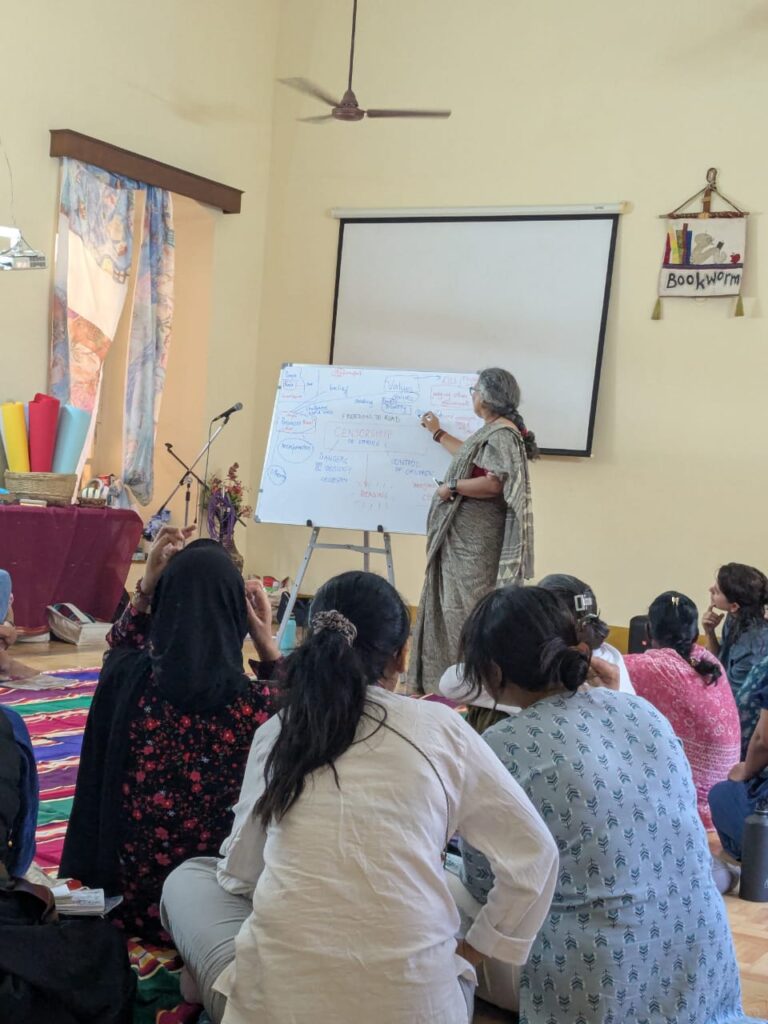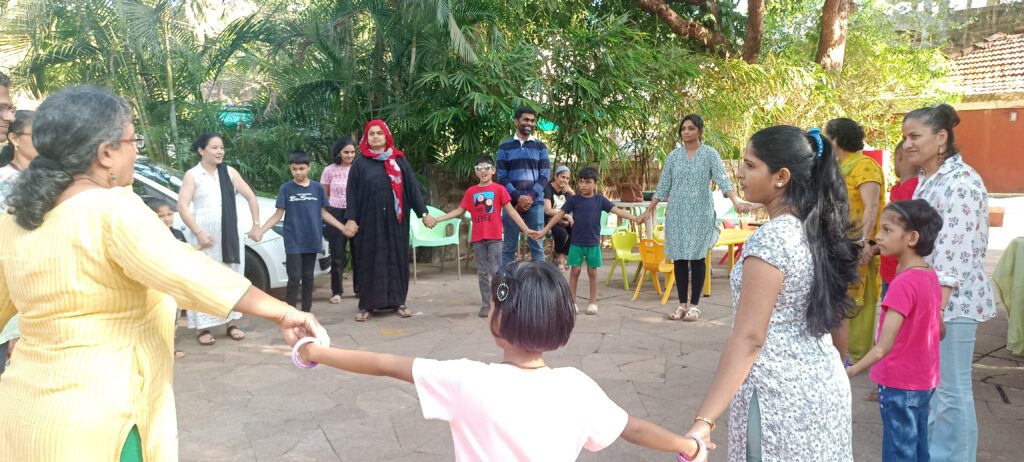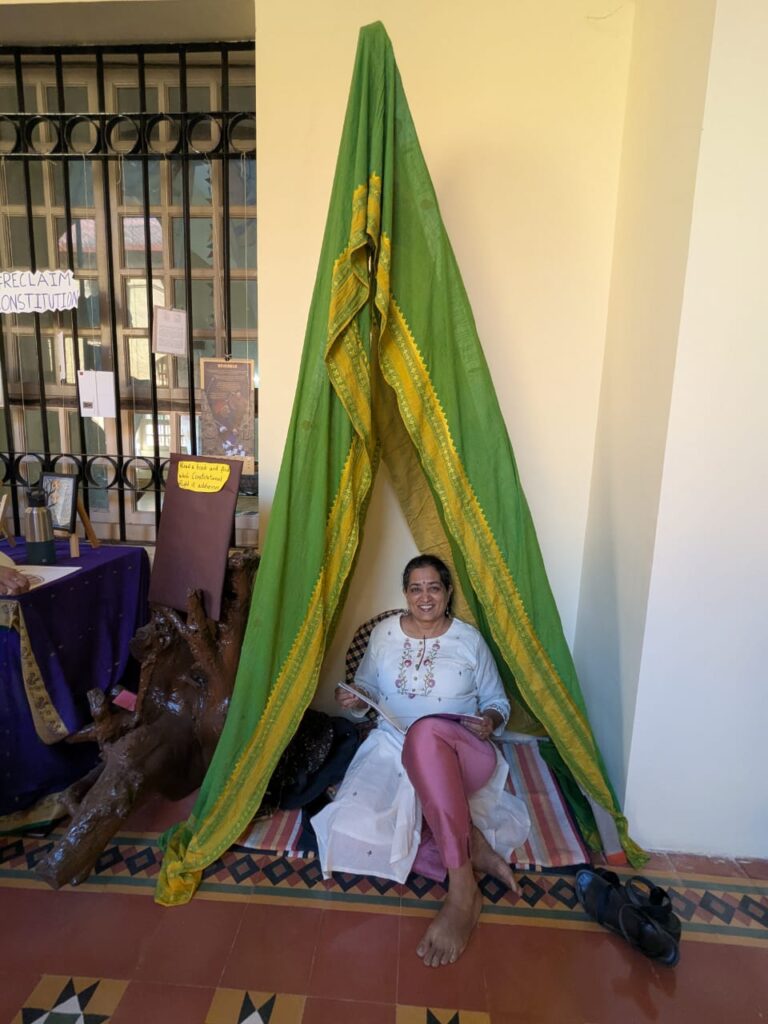Author- Prema Basargekar
Childhood is often imagined as a beautiful stage in one’s life which you always remember fondly, which nourishes your soul and which gives you strength to face challenges in future. This was my tentative idea about childhood before I joined the LEC course. How naïve and innocent I was!
When I began my travel plans for my first contact period of LEC (2024-25) which was to be conducted in Bambolim Beach Resort, Goa, I packed my swimwear in anticipation of taking a dive in the sea after the day’s long training gets over. Never did I imagine that I would be taking a deep dive into ‘childhood’ instead.
The great myth around ‘childhood’ being an innocent, pure and simplistic phase in one’s life was quickly debunked on the first day itself with a small activity. Through an engagement that prompted us to think about our own childhoods, it became clear that all of us were in different positions, urging us to see that although most of us came from similar backgrounds in terms of economic class, and education, we had diverse childhood experiences. I understood that childhood is a far cry from the unimaginative and prototyped representations in popular children’s literature and textbooks.
This understanding had a profound impact on as I began my journey as a library educator. I understood that if childhood is about joy, excitement, mischief, adventures, hope, and about embracing the future with open arms; it is also about pain, despair, loneliness, the feeling of being excluded, groping in the dark to comprehend realities, and deep entanglement in emotional issues. It is not that I was not aware of the fact that children need to face these issues one day and learn to cope. . But I was protective in my mind, and instinctively wanted to shelter them as much as possible simply by urging them to pay more attention to the brighter side of things. I realized that by doing so I may fail them in many ways – by avoiding realities rather than becoming aware of them and accepting them,, by missing out on opportunities for conversation around the issues they find important, by not letting them find out alternative ways to cope with these issues, and most importantly by not letting them know that they are not alone in facing these situations.
The understanding of diverse childhoods is essentially the backbone of any good children’s library. Every aspect of the library – the location, the space, the ambience, the accessibility of books, the timings, library practices, the languages used, is connected with it. If reading helps you to become a participant of the world by allowing you to observe, understand different perspectives, see different lives, and travel to different times; it is also obvious that the library collection should represent the same. The “Window, Mirror and Sliding glass door’ metaphor coined by Rudine Sims Bishop is very popular in children’s literature. The “Mirror” means when readers see their lives reflected in the stories. The “Window” means when stories allow readers to see the world different from their own and the “Sliding glass door” means when readers feel transported into the world of the story and when they can feel empathy for the characters from the story. Any child entering the library is entitled to fulfill this experience. Diverse stories from different regions, languages, socio-economic classes, and childhood experiences will not only allow the child to think empathetically, but will also foster deeper understanding of the world around them.
In our first contact period I was blown away by Bookworm’s collection that was made available to us. It was thoughtful and culturally rich; tenaciously built and curated over a number of years. It helped me connect easily with the ongoing discussions around ‘diverse childhood’ in the classroom – its relevance, and its beauty. This is where I met Ahmed from Cairo introducing me to his city as he works hard to earn for his family, where Japanese children sent to prison camp write letters to their librarian thanking her for the gift of books, where a young girl traces her journey to old Delhi to remember her departed mother, where a young girl, Sita, braves an angry river all alone on a small island, where a small boy, Badeyya from the Madiga caste from a tribal village learns to make sandals for his mother so that she will not have to walk barefoot the next day, where a young boy shares his family recipe of head curry from a ram’s head and the family uniting for a good meal, and a small girl Nasreen risking her life to get educated amidst the Taliban regime. I felt as if these books and these children were waiting for me patiently to pick them up and talk with me, tell me their secrets and share their vulnerabilities, placing a lot of trust in me. Many such stories from diverse backgrounds have enriched my understanding about childhood. These honest and sensitively written stories made me see the beauty in small things which sometimes only children see, and made me understand the unbeatable spirit of children to find joy even in the most adverse situations. I also realized that children are not fragile in the face of challenge as I had thought them to be. In fact they carry great wisdom and uncanny ways to deal with what they face. It is astonishing to see that no matter which part of the world the story is written, and whomever its author, this truth rises to the surface. Every time I finished reading such a book, I made two promises to myself and to the characters in the book – that I will visit the book once again, and that I will find new friends, and readers to meet them. Then I thought, isn’t that itself the job of a good librarian?
Book References
- The Day of Ahmed’s Secret, written by Florence Parry Heide, illustrated by Ted Lewin
- Write to Me: Letters from Japanese American Children to the librarian The Left Behind, written by Cynthia Grady, illustrated by Amiko Hirao
- Letters to Ammi, written by Mohammed Aftab Yusuf Shaikh, illustrated by Adrija Ghosh and Soumitra Ranade
- Angry River, written by Ruskin Bond, illustrated by Trevor Stubley
- Tataki Wins Again and Braveheart Badeyya, written by Gogu Shyamala, illustated by Pooja Vaish, Rashmi Mala, translated by Sushil Joshi
- Head Curry, written by Mohd Khadirbabu, illustrated by Gulam Mohammed Shaikh, translated by A. Suneetha
- Nasreen’s secret School: A True Story from Afghanistan, written and illustrated by Jeanette Winter



